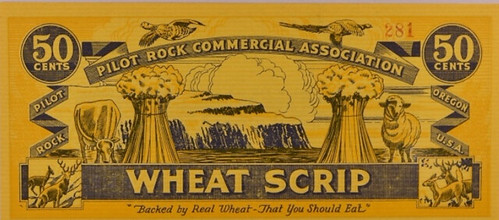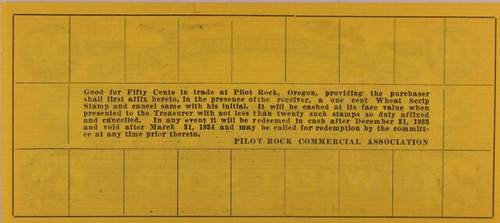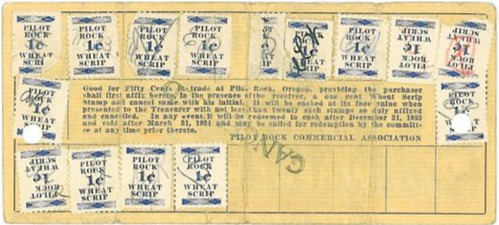
PREV ARTICLE
NEXT ARTICLE
FULL ISSUE
PREV FULL ISSUE
STAMP SCRIP IN THE GREAT DEPRESSIONI noticed a neat piece of Depression scrip on the Coin Talk discussion board this week. User 'Collecting Nut' posted an image of a 1933 50 cent "Wheat Scrip"
note from the Pilot Rock Commercial Association of Oregon -Editor
  To read the complete article, see:
The inspiration for the town's name is pictured on the front of the note. Here's more from the town's web page. -Editor
The City of Pilot Rock was named for the prominent basalt rock formation (pictured) located on the west side of the town which was visible from the old Oregon Trail and used as an aim point by wagon trains traveling Emigrant Pass and Cabbage Hill. Pilot Rock is located in Northeastern Oregon approximately 15 miles south of Pendleton in the foothills of the Blue Mountains. It is a small community of 1542. The main industries are timber and agriculture. Pilot Rock is home to one mill: Boise Cascade /Kinzua Lumber, a lumber and pole mill. To visit the Pilot Rock web site, see:
 That pattern of rectangles on the back isn't just for decoration. Users of the scrip were supposed to affix a stamp in one of the blocks on making each transaction. The intention was to force the scrip to circulate among the community and facilitate commerce until the banks reopened. I don't know the town's population in 1933, but must have been small. Could it support that level of scrip circulation? Searching for an image of one of these notes with stamps affixed, I came across a great 2010 article on the topic of stamp scrip from a the International Journal of Community Currency Research. I knew there were organizations out there for issuers of community currency, but was unaware of this journal. it was a delight to find. Here's an excerpt. -Editor The Great Depression of the 1930’s led to considerable monetary experimentation. This paper, drawing mainly on examples from the American state of Iowa, examines the rise and fall of one of these experiments – stamp scrip. This was a self-liquidating currency: special stamps had to be affixed to the scrip certificate that financed a fund that would redeem the scrip once a sufficient number of stamps had been attached. Although the results of many stamp scrip experiments were disappointing, the best schemes provided some communities with benefits during the worst of the Depression. In the exceptional circumstances of a major financial meltdown, therefore, stamp scrip might conceivably be able to assist a community in reducing the effects on economic activity of such a shock. A Short History of Stamp Scrip
Time-based stamp scrip, by contrast, required that a stamp be affixed to the scrip certificate every week (or fortnight, or month), regardless as to whether it had been used (or how many times it had been used) in the interim. There was also a hybrid version that combined the two: a stamp had to be affixed for each transaction, but if the scrip were not used by a the specified date, a stamp had to be stuck on to maintain its validity. The idea of financing poor relief through the means of transactions stamp scrip appears to have originated in Anaheim, California, in 1931-32. A service station manager, Joe Elliott, devised a plan whereby the unemployed of the city would be given jobs on make-work schemes, and paid with special dollar certificates. They could spend this at the shops of participating merchants, who would then put a special four-cent stamp on the back of the certificate, before passing it on to their employees or customers. Each time the certificate was used, the receiving business was responsible for adding an extra four-cent stamp, until the certificate had 25 such stamps on the back, when there was enough money in the kitty to redeem the stamped coupon for cash. The idea initially worked well. In January 1932 first twenty-five, and ultimately 157 men were working for the scrip. However, when the experiment came to an end after three months, there was too much scrip in issue, and too few stamps had been sold to redeem it. Elliott made up the shortfall, at a personal cost of $1800, around $30,000 in today’s money The article mentions the Pilot rock scrip and pictures a cancelled note. -Editor
 Sometimes an issue of scrip was partially backed by some commodity, which had a similar effect, increasing its acceptability. Pilot Rock, Oregon issued stamp scrip based on wheat: the 50c coupon required only 20 1c stamps to be affixed: the rest of the value was obtained from the wheat against which the scrip had been issued. To read the complete article, see:
Wayne Homren, Editor The Numismatic Bibliomania Society is a non-profit organization promoting numismatic literature. See our web site at coinbooks.org. To submit items for publication in The E-Sylum, write to the Editor at this address: whomren@gmail.com To subscribe go to: https://my.binhost.com/lists/listinfo/esylum All Rights Reserved. NBS Home Page Contact the NBS webmaster 
|
